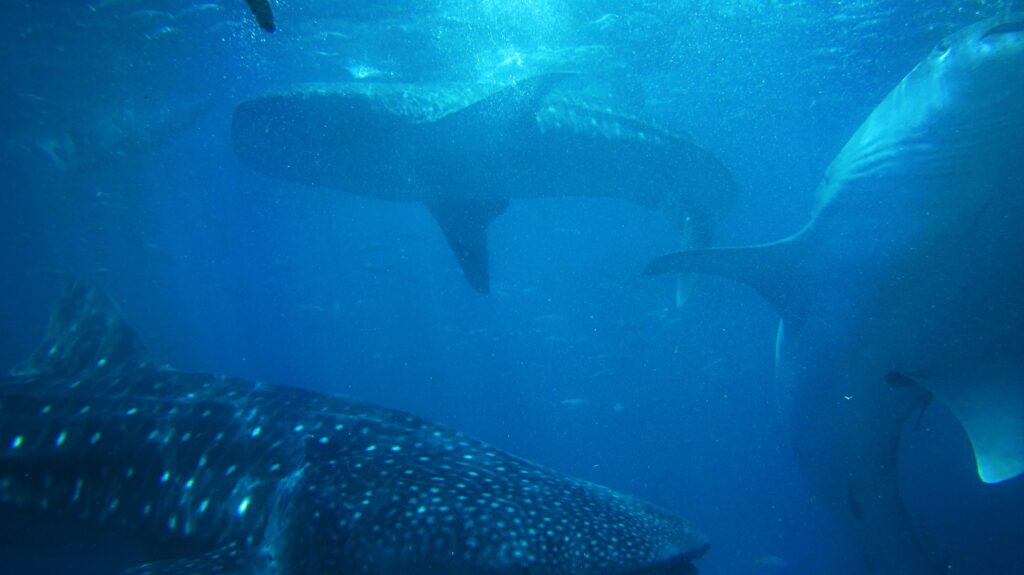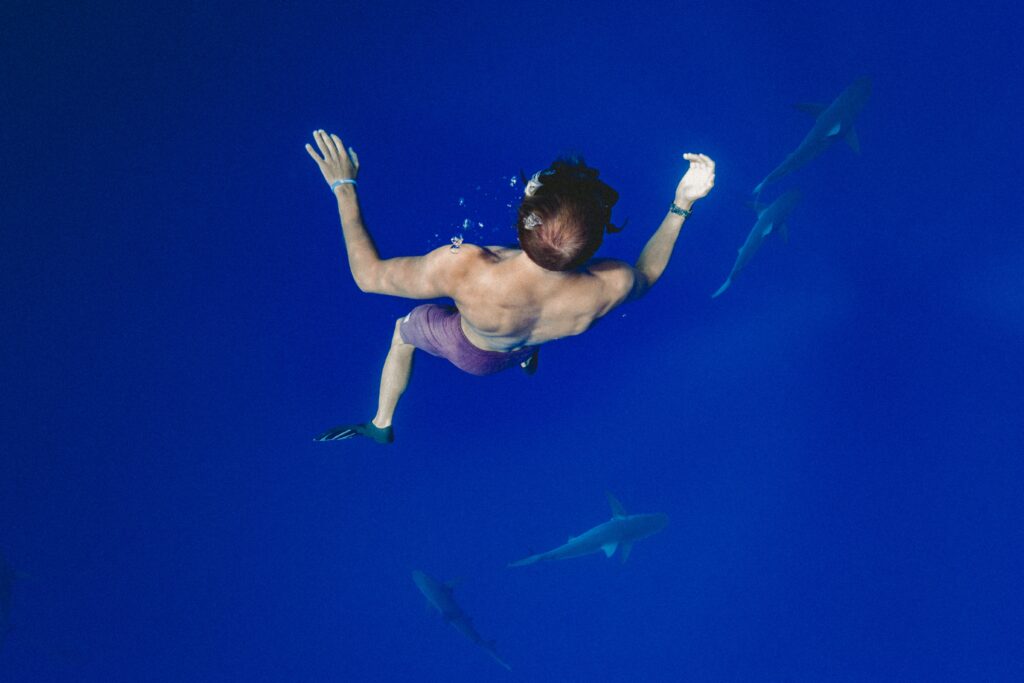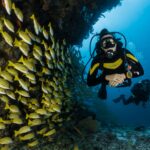So, you’re planning on taking a dive into the big blue and you’re curious about the likelihood of encountering a shark’s powerful bite. Well, let’s get right to it. The chances of getting bit by a shark while scuba diving are actually quite low. While it may be easy to get caught up in the fear fueled by movies and sensational headlines, the truth is that sharks are generally not interested in having humans for lunch.
Now, I’m not saying there is absolutely no possibility of a shark encounter, because the ocean is their home after all. But here’s the deal – sharks are intelligent creatures and they usually prefer their natural prey, such as fish and seals. They’re not out there actively hunting humans. In fact, the chances of a shark mistaking you for a tasty treat are incredibly slim. With millions of people venturing into the ocean each year to scuba dive, the incidents of shark bites are incredibly rare. So, go ahead and take that dive with peace of mind, knowing that the chances of a shark encounter are quite low.
Factors that Influence Shark Bites
Shark bites can occur for various reasons, and understanding the factors that influence them is crucial for ensuring the safety of scuba divers. Here, we will explore the different factors that can contribute to shark bites and provide valuable insights to help minimize the risk.
Types of Sharks
The first factor to consider is the type of shark you may encounter while scuba diving. Different shark species have varying behaviors and diets, which can influence their likelihood of attacking humans. For example, the great white shark is known for occasional predatory behavior towards humans, whereas other species like whale sharks are filter feeders and pose little to no threat.
Time of Day
The time of day can also affect the chances of encountering a shark. Sharks are most active during dawn and dusk, as these are their preferred hunting periods. Diving during these times may increase the likelihood of a shark encounter. However, it is essential to note that shark bites are still relatively rare occurrences, even during peak activity periods.
Location
The location where you choose to scuba dive plays a significant role in the likelihood of encountering sharks. Certain areas, such as popular feeding grounds or breeding areas, are more likely to have higher shark populations. Additionally, diving near areas with abundant marine life, such as coral reefs or seal colonies, can also increase the chances of encountering sharks, as they are attracted to these food sources.
Water Conditions
Water conditions, such as visibility and temperature, can impact shark behavior and the likelihood of encountering them. Poor visibility, caused by factors like sedimentation or murky water, may increase the chances of a shark bite as the shark may mistake a diver for prey. Furthermore, changes in water temperature or currents can influence shark migration patterns and their presence in specific areas.
Behavioral Patterns of Sharks
Understanding the behavioral patterns of sharks is crucial for predicting their interactions with scuba divers. By recognizing their natural prey, provoked behavior, feeding zones, and migration routes, divers can minimize potential risks.
Natural Prey
Sharks primarily feed on marine animals like fish, seals, and sea lions. Understanding their natural prey can help avoid situations where a diver may be mistaken for food. For example, if sharks are commonly found in areas with high seal concentrations, it is important to exercise caution while diving in those regions.
Provoked Behavior
Sharks can exhibit aggressive behavior when provoked, such as when they feel threatened or cornered. It is crucial for divers to respect their space and avoid activities that could agitate or startle them. Avoiding sudden movements, loud noises, or direct eye contact can help prevent a potentially dangerous interaction.
Feeding Zones
Sharks have preferred feeding zones where they are more likely to be present. These areas are typically abundant in prey species and can attract sharks looking for a meal. Divers should be aware of these feeding zones, as the chance of encountering a shark is higher in these areas. However, it is important to remember that sharks are not solely driven by hunger and can still behave unpredictably, even outside these zones.
Migration Routes
Sharks often follow specific migration routes during different seasons. Divers should be aware of these patterns, especially when planning dives near shark migration routes. By understanding their movements, divers can plan accordingly and avoid areas with a high concentration of migrating sharks.

Scuba Diving Precautions
To ensure safety while scuba diving in areas known for shark populations, it is essential to take specific precautions. By following these guidelines, divers can minimize the risk of shark encounters and promote a safe diving experience.
Dive in Groups
Diving in groups is highly recommended, as sharks are more likely to approach solitary individuals. The presence of multiple divers can deter curious sharks and reduce the chance of an aggressive interaction. Additionally, diving in a group allows for increased awareness and the ability to assist each other in case of emergencies.
Avoid Shiny Objects
Sharks are attracted to shiny objects that may resemble the scales or reflective surfaces of their natural prey. Avoid wearing or carrying anything that may catch their attention, such as shiny jewelry or reflective dive equipment. By reducing shiny objects, divers can lower the chances of enticing a shark to investigate further.
Be Mindful of Wetsuits
The color and pattern of wetsuits can inadvertently attract sharks, especially if they resemble the appearance of their prey. Avoid wearing wetsuits with patterns or colors that can be confused with marine animals commonly hunted by sharks. Opt for neutral or muted colors instead, which are less likely to catch a shark’s attention.
Stay Alert and Observant
Maintaining situational awareness is crucial while scuba diving. Constantly scan the surroundings and be observant of any sudden changes or unusual behavior, both from the marine life and other divers. Being aware of your surroundings allows for early detection of any potential threats and enables quick action to prevent a shark encounter.
Incidents and Shark Bite Statistics
Understanding the occurrence and frequency of shark bites can provide divers with valuable insight into the risks associated with scuba diving. Let’s explore the global shark attack statistics, incidents surrounding scuba diving, and the trends observed over time.
Global Shark Attacks
Shark attacks occur worldwide, but it is important to note that they are still relatively rare incidents. According to the International Shark Attack File, there were 140 confirmed cases of unprovoked shark attacks worldwide in 2019. Out of these incidents, only 64 were on humans, with the majority being non-fatal.
Shark Attacks while Scuba Diving
Scuba diving-related shark bites are even more infrequent. While there have been incidents involving sharks and scuba divers, the numbers remain relatively low compared to other water activities. Proper adherence to safety guidelines can significantly reduce the chances of a shark encounter while scuba diving.
Fatalities and Injuries
Fatalities resulting from shark bites are rare, accounting for a small fraction of overall global water-related deaths. Injuries, although more common, are still statistically minimal when considering the number of people engaged in water sports and recreational activities each year. Given the global population and the popularity of scuba diving, the risk of a shark bite remains incredibly low.
Trends Over Time
Trends in shark bites show a relatively stable global pattern, with some regional variations. Researchers attribute these trends to various factors, such as conservation efforts, improved safety measures, and increased awareness of shark behavior. The number of incidents has remained relatively consistent over the years, indicating that the perceived risk of a shark bite may not align with the actual occurrence.

Understanding Risk Perception
The perception of risks associated with sharks is often influenced by external factors, such as media portrayal and misconceptions. Understanding these factors and comparing the risks to other everyday activities is essential for fostering a more accurate perception and promoting responsible decision-making while scuba diving.
Media Influence
Media coverage of shark attacks can often sensationalize the incidents, leading to an exaggerated sense of danger. Individual stories of shark encounters can dominate headlines, giving rise to a disproportionate fear when compared to the actual statistical risk. It is essential to critically evaluate media coverage and maintain perspective regarding the real frequency of shark bites.
Misconceptions
Misconceptions and myths about sharks further contribute to the distorted perception of their behavior. Movies and popular culture often portray sharks as ruthless predators, instilling unnecessary fear in the minds of people. Educating oneself about the true nature of sharks is crucial in dispelling these misconceptions and understanding their actual behavior.
Comparing Risks
To put shark bites into perspective, it is helpful to compare the risks associated with other everyday activities. For instance, driving a car or crossing the road poses a far greater risk than encountering a shark while scuba diving. By considering the statistical probabilities, one can take an informed approach to assessing the risks and minimize unnecessary fears.
Personal Responsibility
Ultimately, each individual is responsible for their own safety while engaged in scuba diving or any other activity that involves potential encounters with sharks. By arming themselves with knowledge, adhering to safety guidelines, and making informed decisions, divers can significantly reduce the risk of a shark bite. Personal responsibility plays a vital role in maintaining safety and enjoying a fantastic scuba diving experience.
Safety Measures and Precautions
To further enhance safety and reduce the likelihood of a shark encounter, various safety measures and precautions are available for scuba divers. These measures aim to deter sharks from approaching divers or provide immediate responses in case of an encounter.
Shark Repellents
Researchers and experts have developed innovative shark repellent technologies to deter sharks from approaching divers. These repellents often use visual, acoustic, or chemical stimuli to discourage shark interactions. While their effectiveness is still being studied, divers may choose to utilize such devices for an added layer of protection.
Emergency Response Training
Scuba divers can undergo emergency response training specific to shark encounters. These training programs often teach divers how to respond in the event of a shark encounter, emphasizing calm and collected actions to minimize the chances of a bite. Being prepared with the necessary skills and knowledge can significantly improve diver safety.
Public Awareness and Education
Public awareness campaigns and educational initiatives play a vital role in promoting responsible behavior and reducing the risk of shark bites. By educating the general public about shark behavior, habitat conservation, and responsible diving practices, these efforts contribute to a more informed and safety-conscious diving community.

Expert Tips and Advice
Experts in the field of marine biology and shark behavior offer valuable tips and advice to scuba divers to enhance their safety and enjoy their diving experiences. Let’s explore some of their key recommendations.
Choose Shark-Smart Destinations
When planning a scuba diving trip, consider destinations that are known for their shark-diving practices and take measures to guarantee diver safety. These destinations often have experienced guides and follow strict safety protocols to ensure both the safety of divers and the sharks.
Follow Local Regulations
Respect and adhere to local regulations and guidelines set by authorities, marine parks, or protected areas. These regulations help maintain a balance between conservation efforts and providing divers with a safe and memorable experience. By following the rules, divers contribute to the preservation of marine ecosystems while minimizing potential risks.
Learn about Shark Behavior
Before embarking on a scuba diving adventure, take the time to learn about shark behavior and understand their ecological role. Organizations, scientific studies, and educational resources provide valuable information that can help divers make informed decisions and ensure a safe diving experience.
Stay Updated with Research
Shark behavior and our understanding of their interactions with humans are continually evolving. Stay updated with the latest research and findings concerning sharks to enrich your knowledge and adapt your diving practices accordingly. Knowledge is a powerful tool in reducing risks and fostering better coexistence between humans and sharks.
Case Studies and Real-Life Experiences
Case studies and real-life experiences provide first-hand accounts of encounters with sharks while scuba diving. These stories, often shared by experienced divers, can serve as valuable learning opportunities while highlighting the rarity and significance of such encounters.
Survivor Stories
Survivor stories recount the experiences of divers who have encountered sharks and successfully averted any harm. These stories emphasize the importance of remaining calm, adhering to safety guidelines, and taking appropriate actions to minimize the potential for a dangerous encounter.
Close Encounters
Close encounters with sharks, where divers have had non-aggressive interactions, provide insights into how sharks typically behave in the presence of humans. Sharing these encounters helps foster a greater appreciation for these magnificent creatures while dispelling unfounded fears.
Diver Encounters with Sharks
Diver encounters with sharks can vary greatly, ranging from peaceful observations to more unpredictable behavior. These real-life experiences showcase the diversity of interactions and provide divers with valuable insight into how to handle different scenarios. Learning from the experiences of others is an excellent way to enhance one’s own preparedness and ensure a safe diving experience.

Conservation Efforts and Stewardship
Protecting shark habitats and advocating for their conservation is crucial for promoting sustainable diving practices and ensuring the long-term survival of these remarkable creatures. Scuba divers have a unique role to play in shark conservation and can actively contribute to stewardship initiatives.
Role of Scuba Divers
Scuba divers often serve as ambassadors for shark conservation. By promoting responsible diving practices and raising awareness about the importance of preserving shark habitats, divers can inspire others to appreciate and protect these magnificent creatures. Encouraging eco-friendly diving practices and participating in citizen science initiatives can further contribute to our understanding of sharks and their conservation needs.
Protection of Shark Habitat
Preserving the natural habitats of sharks is vital to their survival. Supporting initiatives that aim to establish marine protected areas and conserve critical shark habitats ensures the long-term health and viability of shark populations. By protecting their habitat, we protect not only sharks but also the entire marine ecosystem.
Advocacy and Legislation
Advocacy efforts play a crucial role in shaping legislation and policies that protect sharks from overfishing, finning, and other detrimental activities. Supporting organizations dedicated to shark conservation, signing petitions, and actively engaging in discussions can help drive positive change and secure a brighter future for these incredible creatures.
Conclusion
While the fear of shark bites is often exaggerated, understanding the factors that influence shark behavior and following safety guidelines can significantly reduce the risk to scuba divers. By recognizing the importance of responsible diving practices, staying informed about shark behavior, and actively participating in conservation efforts, divers contribute to the coexistence of humans and sharks. With proper education, awareness, and precautions, scuba diving remains an exhilarating and safe adventure that allows humanity to appreciate the beauty and wonders of the underwater world.

- Can You Dive With Sharks In California? - August 19, 2024
- What Are The Rules Of Shark Cage Diving? - August 19, 2024
- Where In Florida Can You Dive With Sharks? - August 19, 2024








